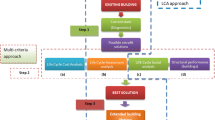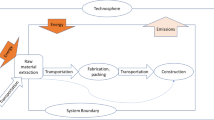Abstract
Purpose
Numerous strategies have been implemented to reduce the global environmental burden of construction activities in order to achieve sustainable development goals. However, with regard to renovating and retrofitting existing buildings, life cycle assessment (LCA)-based studies mostly focus on the improvement of a building’s energy performance rather than on the structural aspects of the retrofit itself. The present study assesses the life cycle environmental impacts of different replacement options for a typical old flat roof belonging to a masonry building. Three different structural options are considered: reinforced concrete joists and hollow clay blocks, steel joists and concrete slab, and reinforced concrete joists and polystyrene panels.
Methods
The environmental analysis is based on a new approach wherein the structural and functional properties of a new flat roof are set as fixed requirements for the design of the different replacement options. A cradle-to-grave LCA-based study is then conducted for the environmental assessment of the entire retrofit process, including different waste scenarios. SimaPro software and IMPACT2002+ methodology are used for the LCA analysis, enabling quantification of the environmental impacts of the three flat roofing options by means of 4 endpoint and 15 midpoint indicators.
Results and discussion
The environmental contribution of each life cycle phase related to the replacement of the old flat roof is assessed. The results demonstrate that within the life cycle of each option, the use phase and the construction phase have the highest environmental impact, ranging from 60 to 70 % and 50 to 80 % of the total burden in the Climate Change/Resources and Human Health/Ecosystem Quality damage categories, respectively. Having initially set structural and functional constraints for the analysis, the results show that any of the different options exhibits an overall lowest environmental performance. Consequently, specific environmental burdens/categories can be identified to optimize the sustainable retrofit design.
Conclusions and recommendations
The work demonstrates that a comprehensive LCA-based approach can be used to effectively drive the design of structural and functional retrofit operations on existing buildings. This study also shows how a rigorous environmental analysis, conducted by implementing the proposed approach, can influence decision-making for the most sustainable design alternatives.













Similar content being viewed by others
References
AIPE (2006) Associazione Italiana Polistirene Espanso. http://www.aipe.biz/home.php
Allacker K (2012) Environmental and economic optimisation of the floor on grade in residential buildings. Int J Life Cycle Assess 17:813–827
ANPAR (2002) Associazione Nazionale Produttori Aggregati Riciclati. http://www.anpar.org/
Ardente F, Beccali M, Cellura M, Mistretta M (2008) Building energy performance: a LCA case study of kenaf-fibres insulation board. Energy Build 40(1):1–10
Asif M, Muneer T, Kelley R (2005) Life cycle assessment: a case study of a dwelling home in Scotland. Build Environ 11:23
Blengini GA (2009) Life cycle of buildings, demolition and recycling potential: a case study in Turin, Italy. Build Environ 44:319–330
Bonanomi M, De Flumeri C, Lavagna M (2012) Edifici a consumo energetico zero. Orientamenti normativi, criteri progettuali ed esempi di Zero Energy e Zero Emissions buildings. Maggioli Editore
Bribián IZ, Capilla AV, Usón AA (2011) Life cycle assessment of building materials: comparative analysis of energy and environmental impacts and evaluation of the eco-efficiency improvement potential. Build Environ 46:1133–1140
Brignola A, Podestà S, Pampanin S (2008) In-plane stiffness of wooden floor. 2008 NZSEE Conference Proceedings
BUWAL250 Database (1998) Life cycle inventory for packagings, vols. I and II. Environmental series no. 250/I and II. Berne, Switzerland: Swiss Agency for the Environment, Forest and Landscape (SAEFL)
Decreto Legislativo 311 (2006) Disposizioni correttive ed integrative al decreto legislativo 19 agosto 2005, n. 192, recante attuazione della direttiva 2002/91/CE, relativa al rendimento energetico nell'edilizia
Decreto Ministeriale (DM) (2010) 26 Gennaio 2010; aggiornamento del decreto 11 marzo 2008 in materia di riqualificazione energetica degli edifici
DM 14 gennaio (2008) Gazzetta Ufficiale n. 29 del 4 febbraio 2008 - Suppl. Ordinario n. 30 - Nuove norme tecniche per le costruzioni
ELCD Database (2006) European reference life cycle database, European Commission
Ferreira JV, Domingos I (2011) Assessment of Portuguese thermal building legislation in an energetic and environmental perspective. Energy Build 43(12):3729–3735
Frenette CD, Bulle C, Beauregard R, Salenikovich A, Derome D (2010) Using life cycle assessment to derive an environmental index for light-frame wood wall assemblies. Build Environ 45:2111–2122
Gaudreault C (2012) Methods for open-loop recycling allocation in life cycle assessment and carbon footprint studies of paper products. NCASI, National Council for Air and Stream Improvement
Hedemann J, König U (2007) Technical documentation of the Ecoinvent 3 Database. Final report Ecoinvent 3 data v2.0, No. 4. Swiss Centre for Life Cycle Inventories, Dübendorf
Huovila P (2007) Buildings and climate change: status, challenges and opportunities. United Nations Environment Programme, Sustainable Building and Construction Initiative, p 87
IDEMAT2001 Database (2001) The Netherlands: Faculty of Industrial Design Engineering of Delft University of Technology
ISO 14044 (2006) Environmental management. Life cycle assessment: requirements and guidelines
ISO14040 (2006) Environmental management. Life cycle assessment: principles and guidelines
Jolliet O, Margni M, Charles R, Humbert S, Payet J, Rebitzer G, Rosenbaum R (2003) IMPACT 2002+: a new life cycle impact assessment methodology. Int J Life Cycle Assess 8(6):324–330
La Rosa AD, Recca A, Gagliano A, Summerscales J, Latteria A, Cozzo G, Cicala G (2014) Environmental impacts and thermal insulation performance of innovative composite solutions for building applications. Construct Build Mater 55:406–414
Lavagna M, Mondini D, Paleari M (2011) Murature ad alte prestazioni. Valutazioni termiche, acustiche, ambientali ed economiche di soluzioni di involucro in laterizio. Maggioli editore
Nässén J, Holmberg J, Wodeskog A, Nyman M (2007) Direct and indirect energy use and carbon emissions in the production phase of buildings: an input-output analysis. Energy 32:1593–1602
Nicholson AL, Olivetti EA, Gregory JR, Field FR, Kirchain RE (2014) End-of-life LCA allocation methods: open loop recycling impacts on robustness of material selection decisions. MIT, Massachusetts Institute of Technology, Institute of Electrical and Electronics Engineers
Ortiz O, Castells F, Sonnemann G (2009) Sustainability in the construction industry: a review of recent developments based on LCA. Construct Build Mater 23(1):28–39
Papadopoulos AM, Giama E (2007) Environmental performance evaluation of thermal insulation materials and its impact on the building. Build Environ 42(5):2178–2187
Peuportier BLP (2001) Life cycle assessment applied to the comparative evaluation of single family houses in the French context. Energy Build 33:443–450
Piazza M, Baldessari C, Tomasi R (2008) The role of in-plane floor stiffness in the seismic behaviour of traditional buildings. The 14th World Conference on Earthquake Engineering October 12-17, 2008, Beijing, China
Pulselli RM, Simoncini E, Pulselli FM, Bastianoni S (2007) Energy analysis of building manufacturing, maintenance and use: building indices to evaluate housing sustainability. Energy Build 39(5):620–628
ReLUIS (2011) Rete dei Laboratori Universitari di Ingegneria Sismica Linee guida per riparazione e rafforzamento di elementi strutturali, tamponature e partizioni
Report TB (1987) Report of the world commission on environmental and development: our common future. Oxford University Press, Oxford
RICREA (2012) Consorzio nazionale riciclo e recupero imballaggi in acciaio, http://www.consorzioricrea.org/
Rio Declaration on Environmental and Development United Nations Conference on Environmental and Development (1992) UN, Rio de Janeiro
Saiz S, Kennedy C, Bass B, Pressnail K (2006) Comparative life cycle assessment of standard and green roofs. Environ Sci Technol 40:4312–4316
Sonetti G (2011) Environmental convenience of a building retrofit. Proceedings of Conference: people and buildings held at the offices of Arup UK. Network for Comfort and Energy Use in Buildings, London
UNI 10006 (2002) Costruzione e manutenzione delle strade - Tecniche di impiego delle terre
UNI 10355 (1994) Murature e solai. Valori della resistenza termica e metodo di calcolo
UNI 10667-12 (2010) Materie plastiche di riciclo - Polistirene espanso, proveniente da residui industriali e/o da post-consumo destinato ad impieghi diversi – Parte 12: Requisiti e metodi di prova
UNI EN 12831 (2006) Heating systems in buildings: method for calculation of the design heat load
Upton B, Miner R, Spinney M, Heath LS (2008) The greenhouse gas and energy impacts of using wood instead of alternatives in residential construction in the United States. Biomass Bioenergy 32:1–10
Author information
Authors and Affiliations
Corresponding author
Additional information
Responsible editor: Alexander Passer
Rights and permissions
About this article
Cite this article
Napolano, L., Menna, C., Asprone, D. et al. Life cycle environmental impact of different replacement options for a typical old flat roof. Int J Life Cycle Assess 20, 694–708 (2015). https://doi.org/10.1007/s11367-015-0852-4
Received:
Accepted:
Published:
Issue Date:
DOI: https://doi.org/10.1007/s11367-015-0852-4




